Paddle boarding is a fun activity, but one thing that is not so fun is all the price tags it comes along with. Are you curious about its expense? Then worry not, dear reader, as I have delved deep into the world of paddle boards just to uncover the mysteries behind these pricey pieces of equipment.
Well, a paddleboard is Gucci for numerous reasons. For one thing, the material used for its construction can be quite costly. I mean, have you ever tried to buy a single sheet of carbon fiber? It will remove that smile from your face. And don’t you even dare get me started on the cost of labor and production!
As I interpret your silence as a daring act of infuriating me, now I will continue explaining a bill from a mechanic who just emerged from a manufacturing factory looking like a white ghost from a horror movie.
Both he and I will discuss how the production of a paddleboard can prove a snooze fest and what really goes into its production.
But before I start, I want to address the elephant in the room: paddleboarding isn’t a cheap sport. One can argue that it is one of the world’s most expensive hobbies/sports. Now that I’m done making you question your status let’s start.
Reasons Why Are Paddle Boards so Expensive
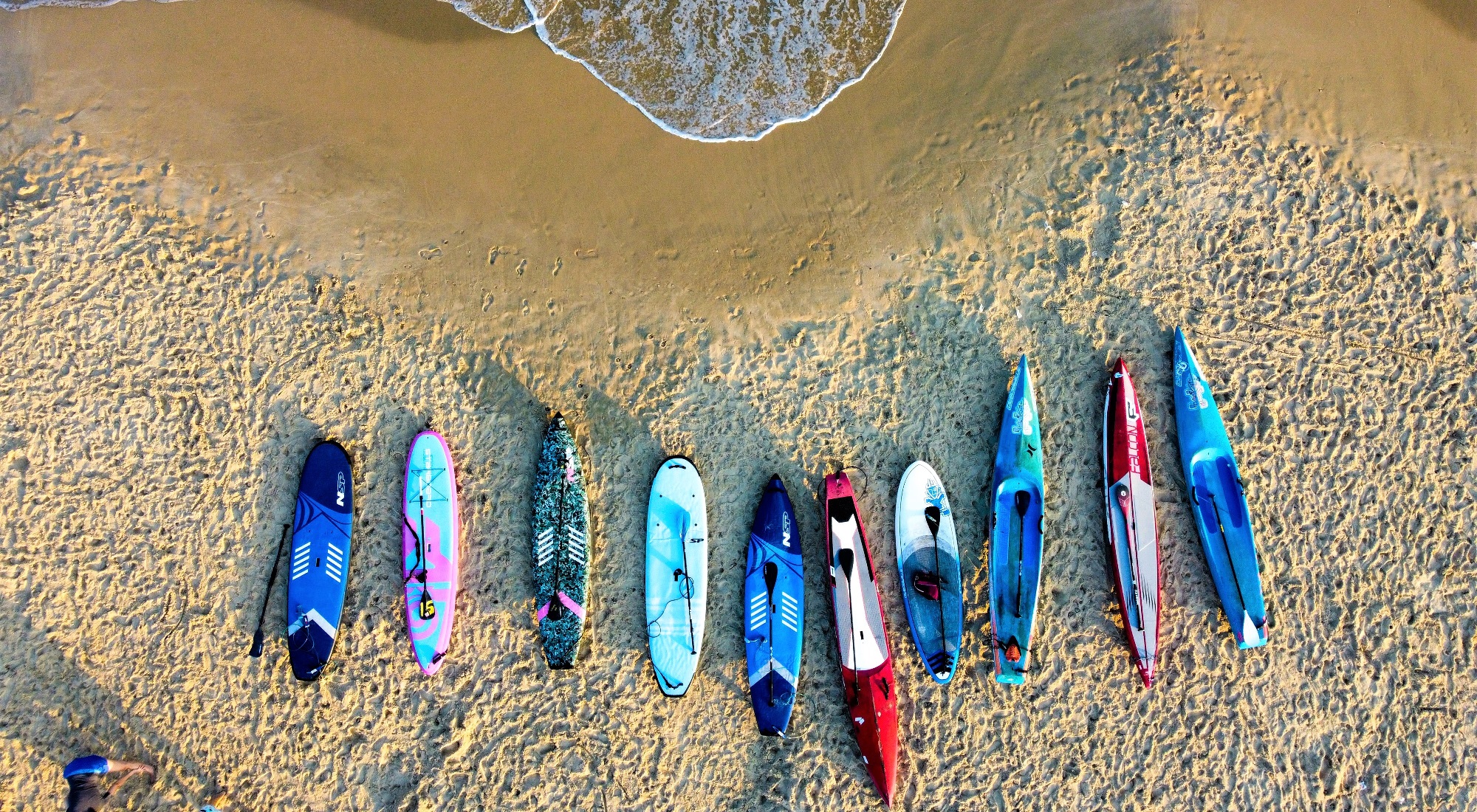
As mentioned earlier, there are many factors that contribute to the overall price of a paddleboard. To mention some:
- Materials
- Manufacturing processes and Shipping
- Research and Development
- Branding and Marketing
- Limited Market/Supply and Demand
Let’s dig deep and see what the big potential expenses that get passed on to the consumer are.
Manufacturing and Shipping Costs
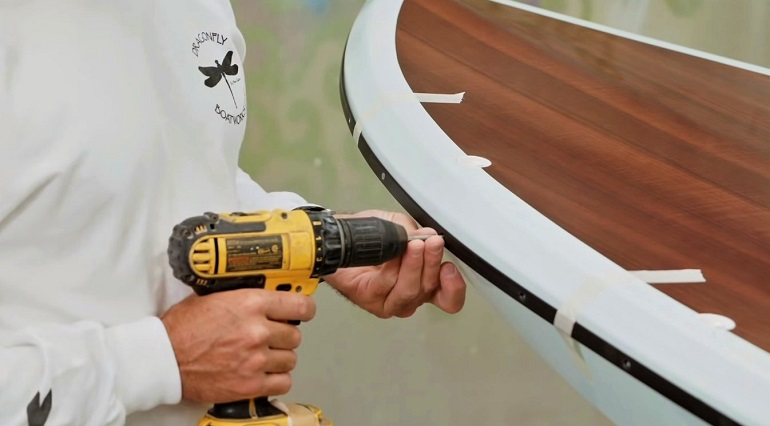
Here, the cost can be a real doozy! So rest your ass tight on the seat as we are going to calculate the trajectory of a rocket ship.
And don’t you dare frown! You will need a lot of brainpower to make sense of it.
You know, it all starts with a concept, an idea, and a prototype. A block of foam that once was pristine and perfect next looks like it’s gone under the hammer.
Well, it literally does. And the irony is the end result doesn’t look more appealing than the original foam.
But who cares? Brains last; beauty doesn’t. Right? We don’t mind watching a mechanic reshaping a foam block into something ugly. Can you stand the sight and later stand on it to paddle around?
Wait! Before you answer and tag it ‘ugly,’ let me tell you that there are hundreds of steps ahead that the board has to cover before it achieves its final look. So let’s not ignore the plastic surgery sessions of this water mattress.
Just so you know, not all paddleboards are manufactured the same way. On the market, both rigid paddle board and inflated paddle board are available, production methods of both also differ largely.
If you are confused about what to buy, do your research on inflatable vs. solid paddle boards, clear your confusions, and decide accordingly.
Inflatable Paddle Boards:

Even though inflatable paddle boards can be less expensive than solid ones, they can also get very expensive.
High-quality inflatable paddle boards are made from advanced fabrics such as drop stitch PVC or other similar composite materials.
These materials are durable enough to withstand abrasion, rigors, and rough handling. Hence, these materials don’t come cheap at all.
To take an example, drop-stitch is a construction method used in most inflatable boards that creates a fabric-like material that is extremely tough and rigid.
The drop stitch construction method involves the creation of a network of thousands of threads that run between the top and bottom layers of the inflatable paddle board.
During its manufacturing, two pieces of fabric are joined together, and higher pressure air is used on it to force threads together. This process results in a mesh-like structure that is further coated with PVC to make a solid paddle board.
Drop stitch construction works like a traditional paddle board and makes the inflatable paddle board lightweight yet sturdy. It allows room for customization in terms of width, length, and thickness. We all desire customization options in every other product, don’t we?
Below are mentioned other parts/materials besides drop-stitch that make high-performant inflatable decks and hence demand more cash:
- Inflation valves
- Rail tape layers
- Linear, reinforced, and woven drop-stitch constructions
- Machine-pressed traction pads
- Polymer layers
- Heat welded PVC
- PVC stringers
- Rocker construction and stiffening materials
- Lamination and adhesives
- Add-ons
- Complimentary accessories
Traditional Paddle Boards:
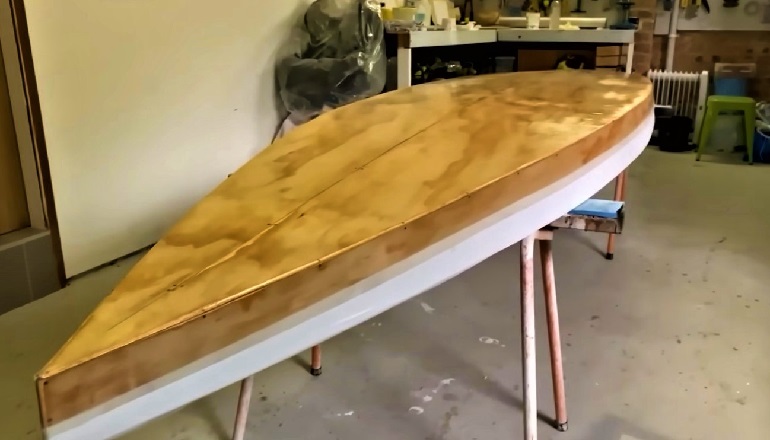
If you look into the traditional paddleboard construction, you will find that it is basically EPS foam blanks molded into decks with added layers of fiberglass. Making fiberglass and wood paddleboards requires skilled labor and expensive materials to accomplish the task.
Many riders like to own multiple paddle boards for different purposes. Each board is composed of multiple layers of different materials to serve the purpose.
You will find a great range of boards, from carbon fiber boards made out of carbon fiber cloth to fiberglass hard boards layered on wood veneer. And all the manufacturing process is done in a factory setting.
The paddleboard goes through a certain number of stages.
First, they shape the foam core, then add fiberglass or carbon fiber layers to it (for carbon fiber paddle board). Next, the epoxy resin is applied, sanding and finishing are done, wood veneers are added, and additional features like fins or deck pads are produced.
Now you see? All these steps require strong manpower.
Now let’s put some light on its shipping. To ensure that the board arrives at the destination in one piece, manufacturers put a lot of thought into its shipping process. You can never guess what kind of shenanigans went on at the shipping company.
If you have ever experienced shipping a heavy object/product, you should have an idea about how much it can cost to ship a weight of up to 20 kg.
Especially if it is getting shipped from China and landing on multiple spots before reaching the final destination. Besides shipping, the transportation cost from the store to the customer also adds to the overall bill.
High Distribution Costs for High-ticket Boards of Popular Brands

Along with many, distribution cost also attributes to the overall cost of a paddle board. Did you know it can increase the actual cost to 20-40%?
You know, most paddle boards are often produced in one location but sold at many.
There are mainly four parties behind the distribution process that is getting a margin and profit out of sales:
- The manufacturer
- The brand/company
- The distributor
- The paddle board store (brick and mortar/online)
However, the antithesis of the above-mentioned system has also been introduced and is popular in the market: Direct-to-consumer (D2C). This system eliminates all the extra parties and builds a bridge between the paddle board manufacturers and the paddle board brand itself.
Still confusing? Don’t you shop online? Do you place the order directly with the company and get your product delivered to your doorstep? There you go!
In the D2C system, the board previously tagged as $1000 is now available at $800. Many famous paddle board brands are working on the same model.
Brands like Bluefin and Decathlon utilize the same procedure of product distribution and hence are being praised by many.
Paddleboards Are Larger than Surfboards
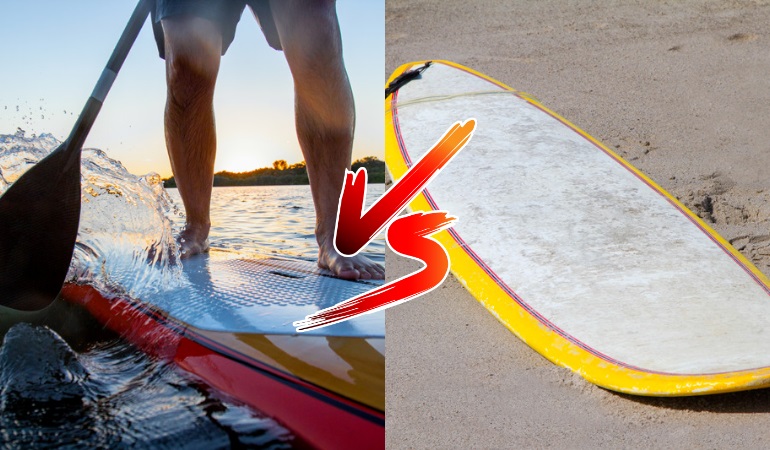
The cost of a paddle board isn’t necessarily determined by the size only; still, the size stands as an important factor when it comes to price. The larger the size, the more it is going to cost the manufacturer. Why so? Because more material and more labor go into its making.
Some people tend to raise a question regarding paddle boards being more expensive than surfboards.
Well, the reason behind that big price tag is also the size of the paddle board. We all know that surfboards are typically shorter than paddle boards.
While a SUP is swanking its eight to fourteen feet long personality, an average surfboard boasts its swift moves with its five to four feet profile. One cannot deny the fact that the best things in life are often the ones that cost a little extra.
Moreover, paddle boards are wider and thicker than surfboards which means more material and more complex manufacturing goes into their production.
Not just this, but the large profile also demands more time for the production process. You can also learn about the detailed comparison between the surfboard and paddle board.
Paddleboards Come with Lots of Gear

Indeed! Paddle boarding requires a variety of gear and equipment. The type and amount of gear all depend on the type of activity you will engage in. Below is a short list of paddle board accessories that you might need:
Paddle:
Essential for propelling the deck, paddles are being offered in different sizes and materials. You will want to select the one that is appropriate for you.
Life Jacket:
A personal flotation device (PFD) and a paddle boarding life jacket are must-haves for safety in the water.
Board Leash:
A leash is a protective device that keeps you close to the board if you happen to fall off the paddle board. With a leash, the deck doesn’t drift away.
Rash Guard:
If you are paddling in chilly cold weather, you might want to don a wetsuit for extra warmth.
Sun Protection:
It is often neglected by paddle boarders, but it makes one important accessory to keep with you while paddling. For unpredictable weather conditions, a hat and sunscreen become mandatory to keep oneself safe from harmful sun rays.
Water Shoes:
Paddleboarding water shoes work as armor and resist slippage on a wet deck or other slippery surfaces.
Waterproof Camera:
In case you want to capture your memories, you will need a waterproof camera enclosed in a waterproof case.
Why You Don’t Want to Buy a Cheap Inflatable Sup
Here are mentioned some important issues you will find in a cheap deck:
Durability:
It is possible to produce cheap paddle boards, but the issue is that such decks are often heavier and prone to damage, so durability comes into question.
Performance:
You might find a problem with tracking or find it hard to tackle choppy waters with a low-quality stand-up paddle board. It might not be as responsive as those solid and rigid paddle boards.
Safety:
A cheap deck will probably be made out of low-quality materials, and that is why cheap boards tend to puncture a lot and lead you into a difficult situation while on water.
Stability:
Cheap inflatable SUPs might not be able to tackle the air pressure that is present within them, which can result in a ruined paddling experience.
Environmental experience:
Manufacturers often stick to unsustainable means of production, especially if they are manufacturing products at cheaper rates.
Just so you know, not all cheap paddleboards are low quality. Some are also made as tough as other hard paddle boards and are available at comparatively lower price points.
How to save Money on Purchasing a Paddleboard?
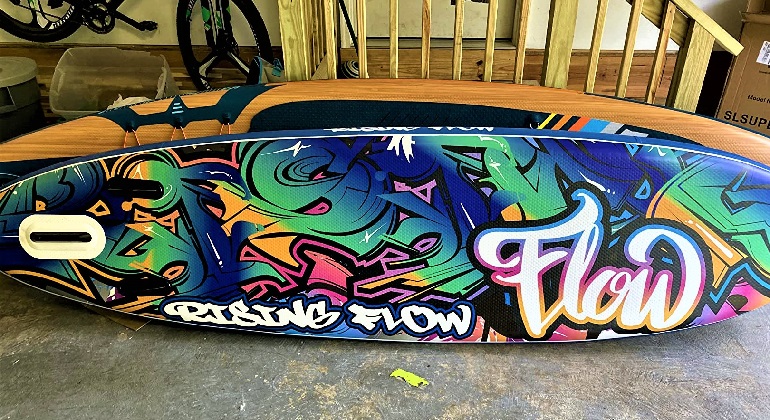
Here are a few tricks one can use to save some dollars while buying a new deck:
Rent Before You Buy:
Especially if you are new to paddle boarding, considering renting a deck is a wise choice.I mean, you don’t even know if you would develop an interest in the sport, so committing to buying already might prove expensive. Most first-time participants stick to this model. If this isn’t what you want, you can pick any option from the beginner paddle boards.
Package Deal and Gift Codes:
Some retailers are offering package deals now and then, and benefitting from one would also save you some dollars.
Off-season Sales:
It is better to buy new gear when the demand is low. Keep an eye out for sales in the winter seasons and get your hands on high-performance decks at cheaper costs for paddleboarding.
Final Verdict
Although paddle boards cost so much, that expensive paddle board that you bought would be worth every penny as you won’t be buying a new deck every year.
Overall the cost can be attributed to many factors, and the most important of them all has been discussed in the article.
From the cost of raw materials to the production cost to R&D, every step demands a heavy amount. But this investment on a high price tag would be worth it for the experience it can provide you.
0 Comments